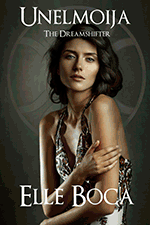by Editor | Aug 22, 2016 | Attractions, Luxury Travel
By Elena del Valle
Photos by Gary Cox

Our meeting place for the tour was the entrance of Les Invalides metro stop in Paris
Over the years I have visited Versailles, the famous palace established by Louis XIV near Paris, France, several times on my own and with large group tours. While the attraction itself was impressive the crowds were oppressive and the logistics to visit it cumbersome. On my most recent stay in the City of Lights, I tried a new approach. I placed myself in the hands of an organized small group program that started and ended in Paris. When I visited Versailles in the past I had to make my own way there from Paris. This time all I had to do was reach the meeting point in central Paris in the morning, and make my own lunch arrangements. The tour company took care of the rest. At the conclusion of the tour our small group returned to Paris together. I was pleased with the results. I appreciated and enjoyed my visit to the 787 hectare palatial estate much more than on most of my previous visits, and was able to discover areas open only to small escorted groups such as ours.

At the train station in Versaiilles
We met Herve Rudrauf, our English speaking French tour guide, by the entrance to Les Invalides RER train station in the tony seventh arrondissement near the heart of the city early morning on a spring Friday. It was pleasantly chilly. The sky was gray and overcast, threatening rain. We were thrilled to discover there were only four of us in the daylong (eight and a half hours) tour. The other two participants in the Full Day Versailles VIP Behind Locked Doors program, organized by City Wonders Tours (6-9 Trinity Street, Dublin, 1-800-358-1942, www.citywonders.com, Info@citywonders.com) were from the United States.
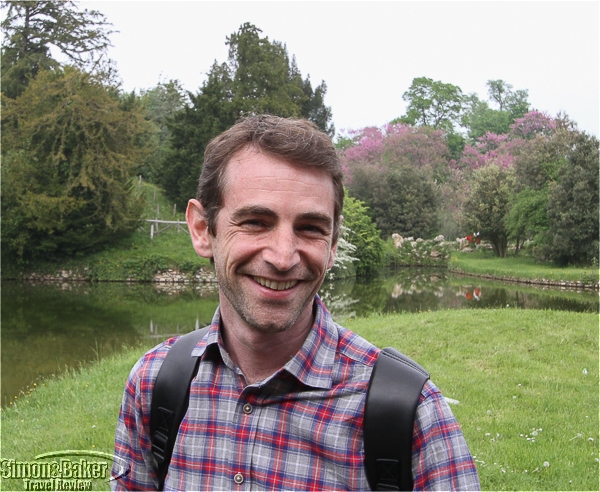
Herve Rudrauf, our tour guide, in the palace gardens
Following greetings, introductions, and instructions Herve handed each of us an RER train ticket and we descended the stairs to the station platform. A few minutes later, we boarded a crowded two level suburban train. It was necessary for our group to split up in order to find seats. Once at the Versailles train station, we found each other and walked together to the palace entrance where, thanks to our tour, we skipped the long admission line. We also had special access to select rooms, such as Marie Antoinette’s private theater, open only to escorted visitors. A staff person provided our group exclusive access.

The Royal Chapel at Versailles
Despite the expedited entry and private visit, the interior of the palace was overcrowded with tourists, sometimes making it challenging for our small group to remain together, hear our guide, take photos and walk from one room to another without being separated. That was not surprising given that some 7.5 million people visit the opulent former royal residence each year, according to a Versailles spokesperson. Although the interior was 63,154 square meters large and the attraction employed as many as 1,000 staff, only 23,072 square meters of the former palace were open to the public, and some of those rooms and halls could only be visited with a guide. A representative from City Wonders indicated that as much as 70 percent of the palace interiors may be visited via an escorted tour.
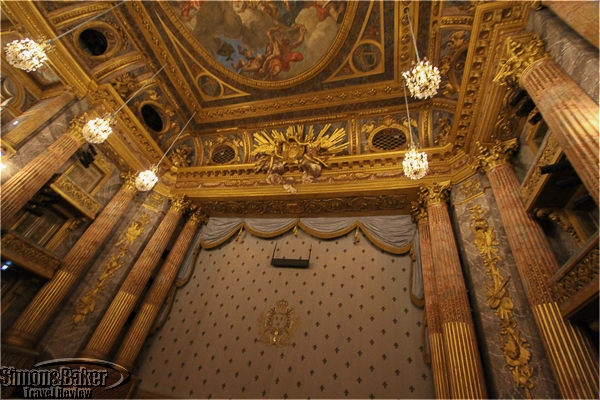
Our private visit of the Royal Opera was memorable.
Because of the uncertain and overcast weather it was a relatively quiet day, our guide explained to our surprise when we commented on the number of people all around us. As we made our way within the storied interior the cacophony of noises competed for our attention. Our eyes and imagination wondered. It was easy to become distracted. Thankfully Herve was efficient at keeping a speedy yet comfortable pace (although restroom breaks were limited and there was no time for the gift shop) while at the same time sharing engrossing information about the former royal residence and its famous occupants.


The palace gardens did not look their best because it was cloudy and rainy.
Anticipating a two hour break for lunch we had made reservations in advance at a gourmet restaurant in the village of Versailles. Unfortunately, by midday we were in the heart of the estate and too far away to return to the village for lunch so we begrudgingly cancelled our booking. Instead we made our way to one of the crowded restaurants within the property. While the service was speedy and efficient lunch was the most disappointing meal we had during that month long trip. We were so hungry after leaving the restaurant we attempted to buy something else at the nearby cafe only to find a slow moving long line and a limited selection of fast food items that appeared no better than what we had already sampled at the restaurant.
Part of what made the tour worthwhile, in addition to our tour guide’s knowledge and enthusiasm, was the access our small group had to areas of the former palace reserved for escorted tours such as ours. Despite huge crowds we had a chance to step behind the cordon at the Royal Chapel for a brief look. We had private visits of the Royal Opera in the main building and the Queen’s Theater in Le Petit Trianon, among of my favorite sections.

A painting of Marie Antoinette at Le Petit Trianon
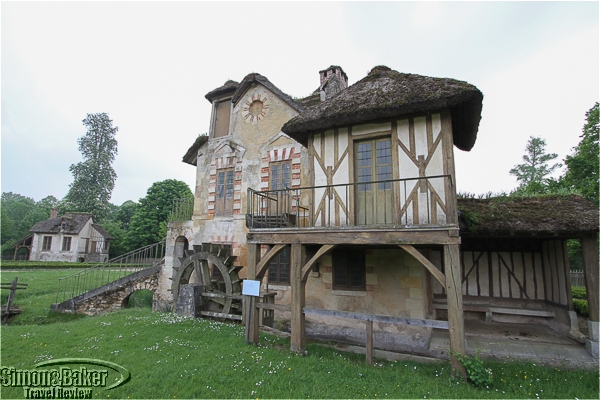
One of the houses in the Hamlet, part of the Versailles estate
After lunch we walked around the gardens, discovering a hidden grotto where the famous queen was said to spend quiet time alone. We also visited Le Petit Trianon, Marie Antoinette’s home away from home while at Versailles; and ambled around the Hamlet, a make believe village within the estate.
Perhaps because before studying to become a licensed tour guide Herve spent several years working as an actor his discussions about life at Versailles were engrossing and entertaining. His interest and passion about French history (he wrote his thesis on the representation of royal power in France), the royal families, and the intriguing stories of inhabitants of the former royal palace were contagious. By the end of the tour, our fellow travelers were asking him for recommendations of books about the history of Versailles and its previous inhabitants.

The ceiling of the Queen’s Theater at Le Petit Trianon
At the conclusion of the Versailles portion of the tour, a taxi, slightly delayed due to strikes, dropped us off at the Versailles train station where we boarded an RER return train to the city. City Wonders Tours, owned by Simone Gozzi, offered the Full Day Versailles VIP Behind Locked Doors tour Fridays and Saturdays only for a maximum of 15 people. The company won the award for the best Guides and Products in Paris 2016 from Get Your Guide. The highlight of the tour was Herve, our friendly, knowledgeable and enthusiastic tour guide who brought the history of Versailles alive. We especially liked the well orchestrated tour logistics, intimate size of our group, and access to private areas. In the future we would be well inclined to book another tour with the same company and the same guide.

by Editor | Jun 6, 2016 | Attractions, Ecotourism
Article and photos by Elena del Valle

The beach at Little Water Cay also known as Iguana Island
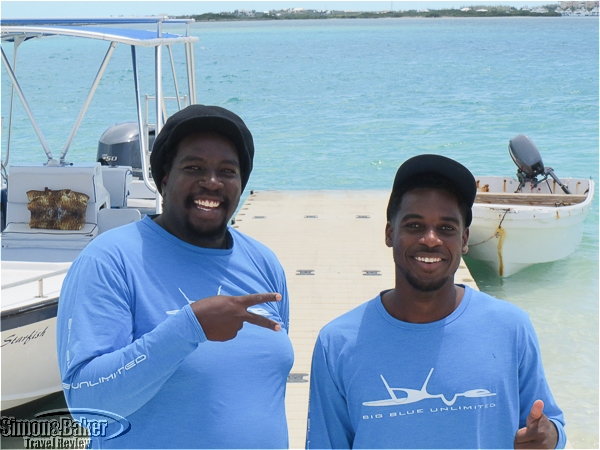
Mike and Cheno were our crew
The day after I arrived in Providenciales in the Turks and Caicos Islands of the British West Indies I received a call from Tanya at Big Blue Unlimited (Leeward Marina, Providenciales, Turks and Caicos Islands, +1 649 946 5034, fax +1 649 946 5033, info@bigblueunlimited.com), a company owned by Mark Parrish and Philip Shearer that specialized in small groups and eco-tours. I was scheduled for a morning snorkel activity the following day, but the weather was about to change and not in a good way. Tanya had kindly found a spot for me that afternoon if I could make it.

Our boat, Starfish
With a little help from Jessica at reception at my hotel, the Beach House Turks and Caicos in the Bight, I was able to reschedule my spa treatment. At 12:30 p.m. I climbed aboard the tour company’s navy blue van with a towel and biodegradable sunblock (as suggested in my booking confirmation) for the drive to the Big Blue Unlimited office at the Leeward Marina to join eight other travelers on a four hour Caicos Cays Cruise. On our way, we picked up six travelers from Club Med. A couple from another property in the Northwest Point met us at the tour company office.
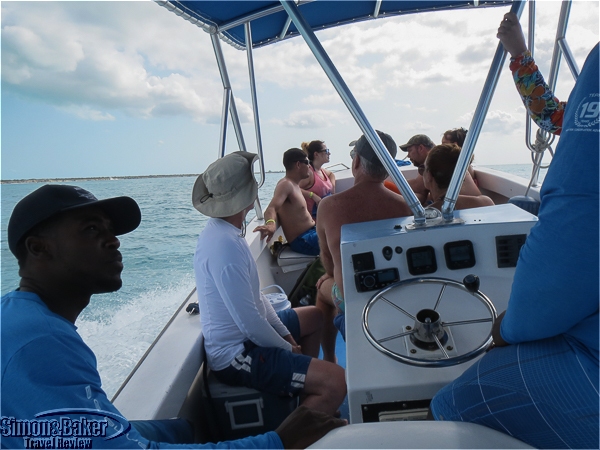
All the passengers and crew on the boat (except for me)
Within minutes of arriving we were ready. After signing a page long release form on an electronic tablet I joined my fellow travelers on the covered deck of the small office. Cheno and Mike, our crew members, introduced themselves and led us to the Starfish, our nine meter long boat for the afternoon. Mike, from North Caicos, had five years of water sports experience, three and a half with Big Blue Unlimited, and Cheno, a dive master from Atlanta and Grand Turks, had seven years of water sports experience, five of them with Big Blue Unlimited. They were friendly and managed the boat well.

A sign for the Little Water Cay Nature Reserve

One of the male Turks and Caicos rock iguanas we saw
The Starfish had cushioned seating for three in the shady stern (back of the boat). It could accommodate the remainder of our group in the sunny bow (front of the boat). On our return to the marina everyone moved forward to avoid the water splashing the stern seat. Our first stop was at Little Water Cay, a small island managed by the Turks and Caicos National Trust, where we saw a number of Turks and Caicos rock iguanas close up. A local guide led the nine of use via a wood walkway, sharing insights about the iguanas and the island. From the small dock we looped around a short distance past palm trees, trust markers and signs, and the mostly unafraid reptiles back to our starting point, and to the boat in about 15 minutes.

The sand was powdery white
I liked that the tour company sought to hire local islanders (a number of employees I met elsewhere on the island were foreign nationals), that its staff had received training about marine and coastal ecology, marine life identification, island geography and geology; and that Big Blue followed and promoted eco-tourism principals, as one of the owners explained by email.

The shallow beach was like a swimming pool with white sand and clear water
From there we motored across turquoise waters to join other tour boats at Leeward Reef, where we remained about one hour. After we tied up to the reef buoy, Mike and Cheno helped us with snorkels and masks, put anti fogging liquid in the masks, and made sure we were comfortable once in the water. Cheno led three of us snorkeling, watching us every so often to make sure we were all right. He pointed out big fish such as an oversize parrot fish, a large grouper, a barracuda and three reef sharks at varying times. The swells were high and the water cool, but the snorkeling at Leeward Reef, about 12 feet deep, made up for the minor discomfort I felt. One of the other guests had to take over counter medication for seasickness when she returned to the boat.

For snacks there were fruit slices, potato chips, muffins and brownies
After snorkeling, we went to Fort George Cay, where Mike and Cheno offered us rum punch or water and snacks of Lays potato chips, chocolate brownies, poppy seed muffins, and fresh fruit (cantaloupe and pineapple slices). Mike and Cheno stayed on the boat while the rest of us enjoyed some beach time. A short stroll from where we got off the boat the beach was shallow and the water crystal clear. It was also the warmest water I swam in during my stay in the Turks and Caicos Islands. We spent about an hour there before riding back to the marina. Moments later, we headed back to our respective hotels in the van. I made it back in time for a shower and an early dinner. For the rest of the evening I thought of the excellent visibility and fun snorkeling and beach. By the following morning the wind had picked up and the waves were choppy at the beach. I was thankful for Tanya’s call and to have enjoyed the snorkeling activity the previous afternoon.

by Editor | Apr 25, 2016 | Accomodations, Attractions, Ecotourism, New Articles
By Elena del Valle
Photos by Gary Cox
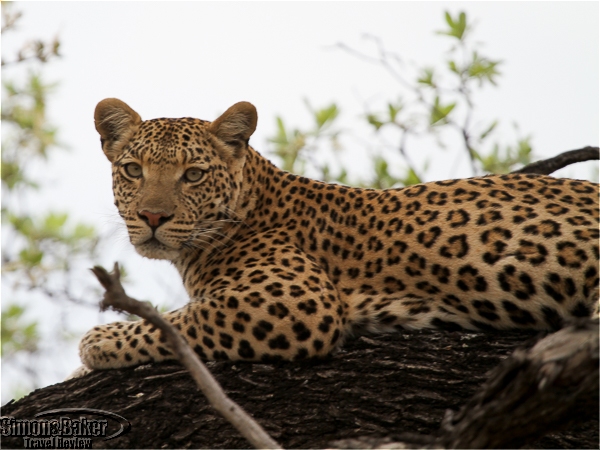
A leopard in a tree near Camp Moremi
On our most recent safari trip to Southern Africa we stayed at six Desert & Delta Safari properties, five in Botswana and one in the Caprivi Strip of Namibia. Traveling to properties within the same company offered advantages. The management similarities provided us an idea of what to expect before arriving at each subsequent property. For example, they all had eco-friendly policies; offered us moist refresher towels on arrival and when we returned from game drives as well as welcome back staff greetings when we returned from our activities; with only one exception, they all served buffet meals of similar styles at shared communal tables; the camps that depended on generators for electricity had battery operated lights for times when the generators were off at night; and most were run by a four-person management team, many of whom were friendly and helpful when asked.

Our pilot bids us farewell after our arrival at Leroo La Tau from Maun to start the adventure

Safari Air had several comfortable Caravan aircraft
Another advantage of traveling to Desert & Delta Safaris properties was their shared charter air service. Since Chobe Holdings Limited owned Desert & Delta Safaris and Safari Air (Desert & Delta Safaris, Private bag 310, Maun, Botswana, +267 6861243, http://www.desertdelta.com, info@desertdelta.com), a non scheduled charter safari airline founded in 1992 and based out of Maun, they coordinated our transfers between the Desert & Delta Safaris properties and between our international arrival and departure airports. The company owned five GA8 Airvan, three Cessna Caravan and one Quest Kodiak. We appreciated the convenience of the well organized and on time service.

The heat drove many poolside in the afternoons
Our stay was hampered in part by a regional heat wave that stretched all the way to South Africa. Four of the six properties ran on generators. Because the rooms remained sealed most of the day they became over hot around the clock. More than once we or our fellow travelers became ill from the heat and dehydration. Thankfully, the game viewing vehicles had partial shade. In addition, wet face cloths and pool dips were helpful in reducing our body temperature.

The wildlife was centered around the Boteti River banks near Leroo LaTau
Leroo LaTau, on the edge of the Makgadikgadi National Park, was our favorite for game viewing and views of the Boteti River from our rooms and the common areas. This was in part because Slade, our guide, was one of the most passionate and engaged of the guides we spent time with on that three country multi week itinerary. We enjoyed seeing a bit of the regional zebra migration and predators such as lions and wild dogs as well as brilliant sunsets over the shallow waters of the river.

Sunset over the Okavango Delta

Time for a drink before dinner at Xugana Island Lodge
In Camp Moremi (see Tented camp offered good game viewing, creature comforts on edge of Okavango Delta) we liked the expansive views from the elevated deck. At Xugana Island Lodge, we delighted in the birding within the island, the sense of remoteness within the famous Okavango Delta, and pretty water setting as well as many boat outings and occasional hippo sightings. Savute Safari Lodge had the prettiest rooms and some of the tastiest and most abundant meals. We especially liked the views of the man made waterholes from the dining area and our tented rooms.

Breakfast at the Chobe Game Lodge with a view of the Chobe River
At the Chobe Savanna Lodge and Chobe Game Lodge, situated on opposite sides of the Chobe River and in separate countries, we were thankful for the air conditioned rooms. Although the border crossing from Botswana to Chobe Savanna Lodge on the Namibia side of the Chobe River was time consuming, hot and tedious we enjoyed the shady leisurely river rides on the pontoon boat. We particularly liked it when our boat was one of few on the river and we were alone with our local guide. The flat river water and quiet when the motor was off were particularly appealing. At the Chobe Game Lodge, we appreciated the three daily game viewing activities, and luxury amenities such as plated meals at private tables, in-room phones, WiFi internet access, work out room, spa room and its innovative electric safari vehicle.
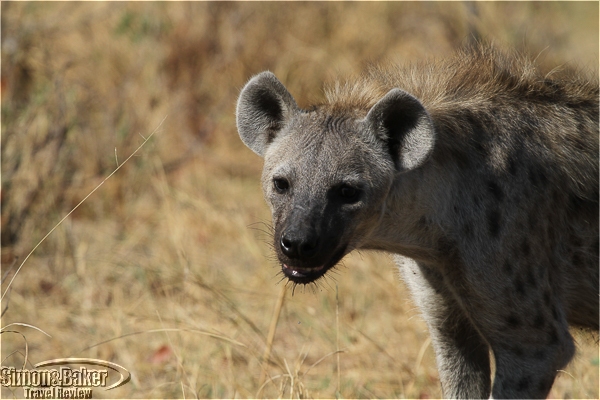
A hyena in the Chobe Game Reserve

Elephants sharing a waterhole near Savute Safari Lodge in Chobe
Overall we had a fun trip and numerous bird and wildlife sightings of common species such as zebra, wildebeest, giraffe, impala, red lechwe (at Xugana), including elephant, buffalo, leopard and lion from the coveted Big Five. We saw beautiful birds, including the elusive paradise flycatchers, fish eagles multiple times, and particularly remember pairs of fish eagles relatively close to our boat at the Chobe Savanna Lodge. During the trip, we had extraordinary sightings such as wild dogs at Leroo La tau, crocodiles hunting, interactions between lions and elephants and numerous striking landscape and waterscape moments that will linger in our memories for years to come, and draw us back to Botswana and Africa in the future.
by Editor | Dec 14, 2015 | Attractions, Food and Wine, Luxury Travel, Restaurants, Wine
Article and photos by Elena del Valle

Blake Gowar at the Eagle’s Nest hilltop
During a recent stay in Constantia, a wine producing suburb of Cape Town, South Africa, I went on a 4.5 hour Private Half Day Wine Tour recommended by the owners of the Glen Avon Lodge where I was staying. At 12 noon sharp, Blake Gowar, owner of The Constantia Wine Tour (11 Midhurst Way, Constantia, Cape Town, 7806, South Africa, +27 021 794 4873, +27 082 377 5233, www.theconstantiawinetour.co.za, Blake@theconstantiawinetour.co.za), picked me up at my hotel in his company branded sports utility vehicle.

One of the historic buildings of the Klein Constantia Estate
During the short drive to Klein Constantia (Klein Constantia Estate, PO Box 375, Constantia, 7848, South Africa, +27 021 794 5188, kleinconstantia.com, info@kleinconstantia.com), the first of three wineries on the tour, we had a chance to chat as I was the only guest on the tour the chilly winter day. Blake explained his was the first and only company dedicated exclusively to half and full day tours of Constantia wineries.

Janine Dodds, our friendly host at Klein Constantia
After passing through the security gate we entered the Klein Constantia Estate. Dating to 1685 the property was built among ancient trees on the upper foothills of the Constantiaberg Mountains. It had a view across the city to False Bay. Although it was in the midst of extensive renovations the tasting room was unaffected. Janine Dodds, a well informed and friendly representative, greeted us and recommended wines for me to taste. We were the only visitors at that moment. Thanks to the quiet off season ambiance I had her undivided attention during the wine tasting. The property was best known for its chardonnay and sauvignon blanc wines. It also had the best stocked gift shop I visited on the tour. There were branded cycling shirts and a variety of foodie and wine items on sale.

The vineyards at Klein Constantia

The garden seen through a glass of rose wine at the Eagle’s Nest
A handful of people had arrived before us at the Eagle’s Nest (Old Constantia Main Road, Constantia, 7848, South Africa, +27 21 794 4095, eaglesnestwines.com, info@eaglesnestwines.com, orders@eaglesnestwines.com) where we received a warm welcome from Kaylee Morrick and Kathleen McNulty. There were still left plenty of table choices in the verdant garden. Following the staff’s recommendation I picked a spot where I tasted a rose and couple of the white wines while Blake went to swap his sports utility vehicle for a four wheel drive. Thanks to a family friendship with one of the owners of the Eagle’s Nest Blake had exclusive permission to use the property owner’s Land Rover and drive up the winery’s mountain for tours.
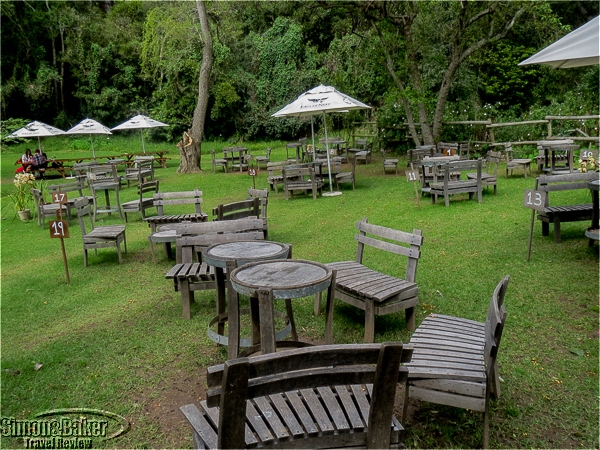
Although it was chilly I was drawn to the lush garden at the Eagle’s Nest
The Eagle’s Nest was in a secluded valley high up on the slopes of the historic Constantia mountain range, part of the Table Mountain area. One of the five small boutique wineries of Constantia it was home to some of the steepest gradient vineyards in the country, Blake explained. The winery was known for its dry rose, viognier and award winning shiraz. The weather worn vehicle climbed the single lane dirt road with the ease of a goat, if slightly less grace. We stopped along the way for some photos and a close up glimpse at flowers.
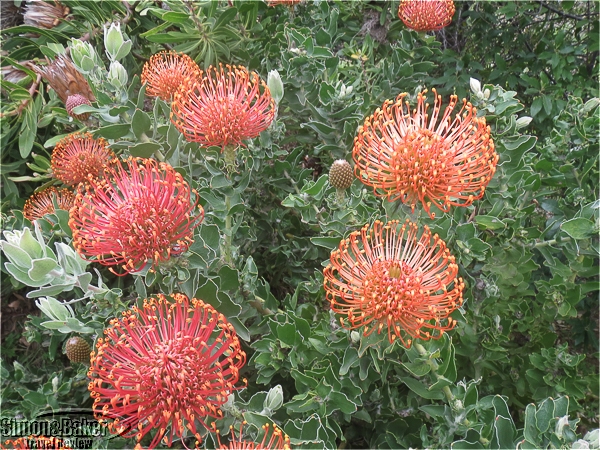
Flowers growing by the side of the road
By the time we reached the high point on the farm the wind had picked up and I was chilled despite my fleece and windbreaker. The panoramic views of the farm, followed by Constantia in the foreground and greater Cape Town beyond reached all the way to the ocean. The breathtaking scenery from the top made the detour worthwhile.

Bird’s eye views of Cape Town from the hilltop at the Eagle’s Nest
On our return to the Eagle’s Nest tasting room, we sat indoors near the crackling flames of the fireplace. The glass walls afforded us a view of the garden during the second half of the wine tasting. I especially enjoyed their three lovely reds.

Our third winery was Silvermist
All that wine tasting had made me hungry. By the time we arrived at Silvermist (Constantia Nek, 7806 Cape Town, South Africa, +27 21 794 7601 silvermistmountainlodge.co.za, silvermistvineyards@gmail.com, silvermisteatery@gmail.com), on the forested slopes of Table Mountain and within the Table Mountain National Park, I was ready for a late lunch and a tasting of the farm produced white. The rustic 120 acre estate that borders the Constantia Wine Route was, I was told, the only organic vineyard in Constantia. It was best known for its sauvignon blanc. Candace Louw, one of the owners, welcomed us warmly when we arrived.

The Silvermist Sauvignon Blanc

The views of Table Mountain National Park at Silvermist
We ate in the Green Vine Eatery, one of two dining venues within Silvermist, where Blake ordered the special of the day, a tasty pizza, and I had a well prepared hamburger with potato wedges. While we waited for lunch we stepped out briefly to enjoy the beautiful views of the environs and Table Mountain. Dessert of chocolate muffins was to go.

The pizza special for lunch at the Green Vine Eatery

Candace Louw, one of the owners of Silvermist
As my tour guide and I parted company, I realized how much I had enjoyed the pleasant pace of the private half day tour, the wine tastings, lunch, and Blake’s company. Although I had visited Constantia before, I had never been to any of the wineries on our tour that day. I appreciated having someone else drive all afternoon. It meant I could taste as many wines as I wanted without worrying about driving. And, I didn’t have to find the wineries with my rental car’s not always trustworthy GPS directions. Plus, it was fun to discover new estates. Blake’s selection of the wineries was spot on in terms of the setting and the wines themselves. The unique opportunity to climb to the high point of the Eagle’s Nest farm was an unexpected bonus.
by Editor | Nov 9, 2015 | Attractions, New Articles
Article and photos by Josette King

Meteora Monasteries – from left to right, Rousanou, Saint Nicholas, Varlaam and Great Meteoron
I first heard of the monasteries of Meteora (Greek for suspended in the air) some 40 years ago and immediately resolved that I must visit, someday. The year was 1975. The military dictatorship that had cast a pall upon Greece for seven years had finally ended and adventurous tourists had begun to return. A friend was telling me of her summer of wandering to the far reaches of the Thessalian Plain and coming upon a surreal landscape of sandstone pinnacles thousands of feet in height topped by fortified medieval monasteries. Built from the 14th to 16th centuries, they were one of the largest monastic complexes in Greece. Of the original 24, only six monasteries remained and were still home to small religious communities. There were no roads or other visible means of access, but she and her traveling companion had managed to visit. Area villagers had suggested they approached the monks who came down for supplies every few days. Chances were they would be allowed to go. Two days later, they were hoisted some 400 meters (1300 feet) above the plain in a basket akin to a small hot air balloon gondola attached to a sturdy rope to the Grand Meteoron Monastery (a.k.a. Monastery of the Configuration of Christ). There, a kind brother who spoke a bit of English gave them a tour of the courtyard and common areas, including a church with fascinating and remarkably well preserved post Byzantine frescoes.

The Monastery of Great Meteoron
It took four decades but the opportunity finally arose for me to keep my promise to myself, in the form of an Athens to Pindus Mountains 4 x 4 Tour with Tripology Adventures. It ended at the place where the foothills of the Pindus meet the northwestern corner of the Thessalian Plain, Meteora. Tripology is an adventure travel company that leads self-drive caravans into remote, history rich areas of the Mediterranean Basin and beyond. While the powerful 4 x 4s that had been a must to see us through the unpaved mountain trails of the Pindus were not technically necessary there, they did come in handy on the steep access road that had replaced the basket ascension of old to reach to the monasteries.

Today’s visitors access Great Meteoron via a narrow stairway
Much has changed since my friend’s visit. The Meteora complex is no longer a well-kept secret. Even before UNESCO declared it a World Heritage Site in 1988, it had already enjoyed its moment in the limelight when James Bond tracked villains to the Holly Trinity Monastery for the scenic suspense ending of his 1981 caper “For Your Eyes Only.” More recently, roads have been constructed up nearby hills with footbridges over the chasms. Visitors walk across to reach steep stone stairways that lead to entrances cut into the fortification walls. With the development of mass tourism, Meteora has become one of the most visited historic sites in Greece. And Kalambaka, the sleepy village where my friend had waited for the monks to show up, is now a thriving modern tourist town. But I enjoyed my comprehensive tour of Great Meteoron, the oldest (established around 1340) as well as the highest of the existing monasteries. With only three monks remaining in residence, most of common areas such as the original kitchen, pantry, wine cellar, refectory and the artifacts of everyday life they still hold have become museum exhibits.
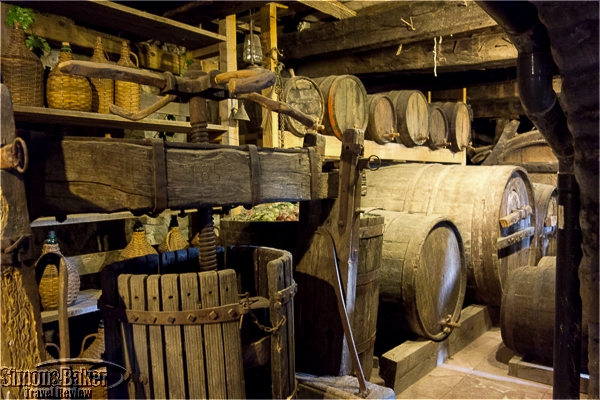
The ancient wine cellar at Great Meteoron
Due to their unassailable location, these remote religious centers had become an academic and artistic safe heaven that kept Hellenic culture and traditions alive during the four centuries of Ottoman occupation of Greece from the mid 15th century to 1821. The Great Meteoron katholikon (orthodox equivalent to a conventual church in Western Christianity), the Church of the Transfiguration that was built in 1388 in the Greek square cross floor plan and topped with an unusual twelve sided dome and the nave and narthex added in 1545 are prime examples of the curatorial importance of the site. The icons adorning the sanctuary trace back to the 14th to 16th centuries. The frescoes of the katholikon, painted in the late 15th century, are in the Macedonian style. They depict the Virgin Enthroned and multiple scenes from the life of Christ, including images of Christ Pantocrator (reminiscent of early Christian mosaics in Istanbul’s Agia Sophia). The nave and narthex frescoes, painted in 1552 in the more rigid style of the Cretan school, recount the early gospels as well the gruesome martyrdom of early saints. They also include portraits of the monastery’s founders Athanasios and Ioajph. In addition to their artistic and historic documentary importance, it was a thrill to see ancient frescoes that had been so well protected by their isolated environment that they were still in their original state and in remarkable condition.

The Monastery of Varlaam
My visit ended with a quiet moment in the shaded courtyard, taking in the dramatic views of the nearby pinnacles and the valley beyond. Despite their world fame, the monasteries serenely go on standing guard, suspended in the sky as they have for over half a millennium. A breathtaking sight that alone would have made it worth my decades long wait.

by Editor | Oct 26, 2015 | Attractions, Wine
Article and photos by Elena del Valle

Some of the Oliver wines I sampled

A water feature near the entrance to the tasting room
By the time we reached Oliver Winery and Vineyards (8024 North State Road 27, Bloomington, Indiana, 47404, +1
812-876-5800, www.oliverwinery.com, admin@oliverwinery.com), 10 miles from the heart of Bloomington, Indiana,
the waning sun was way past its zenith, its rays showing off the winery gardens to their best advantage.
To one side of the entrance, I caught a glimpse of a small pond surrounded by green lawns and inviting picnic tables in the cool shade.

There were many shady spots and picnic tables with a view of the pond

Inside the tasting room there were many displays, chalkboards and art on the walls
As our large group scattered over the outdoor terrace to enjoy the last of the afternoon I made my way indoors to the tasting room. Standing side by side with several colleagues I sampled six wines, some because someone else was sampling them and others I chose. They were: Creekbend Valvin Muscat 2014, Creekbend Vignoles 2014, Creekbend Traminette 2014, Cabernet Sauvignon 2012, Creekbend Catawba Late Harvest 2013, and Creekbend Vidal Blanc Ice Wine 2008. The last two required payment of a supplement beyond the regular tasting menu price. They were the sweetest.

Jim explained how the ice wine was notable because of the winery’s geographic location

A bottle of 2013 Catawba Late Harvest
I was surprised to discover ice wine, the ultra sweet wine made from grapes allowed to freeze naturally on the vine, on the tasting list. Since most of the ice wine I had heard of or tried in the past in North America was from Michigan, New York, Pennsylvania, Oregon, Washington, or Canada (Germany and Austria too) I decided to sample some of their ice wine. Jim, the staff member who looked after us, was friendly and knowledgeable. He answered questions peppered from all sides with patience and interest. He offered each of us wine samples and shared tidbits about the winery and the vineyard only four miles away. Standing at the cozy tasting bar, chatting with fellow travelers about food and wine it was hard to imagine Oliver Winery employed 100 people and produced more than 320,000 cases or 3.8 million bottles of 40 wine types.
Oliver Winery and Vineyards, one of Indiana’s oldest and largest wineries founded in 1972, was under the stewardship of Bill Oliver, son of the company founder. It had two physical locations, a winery that housed the modern 2,400 square foot tasting room where I sampled several wines and the pretty adjacent gardens and grounds; and Creekbend Vineyard, a 56-acre property where they grew the grapes. The company distributed its products in 18 states and shipped nationwide.
























































